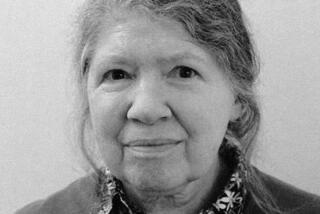Monogamy as Infidelity : A CRAVING FOR WOMEN <i> by Sybil Claiborne (E.P. Dutton: $17.95; 245 pp.) </i>
- Share via
The usual theme for the novel of modern manners is adultery--the causes, effects, repercussions of infidelity on marriage. In “A Craving for Women,” Sybil Claiborne has, so to speak, stood this premise on its head: What happens when stable, polygamous marriages are threatened by monogamy? She posits a man happily married to seven wives, visiting each in turn according to a conjugal calendar. The marriages are rewarding, the wives are friends and co-workers; their congeniality and cooperation, in fact, is given the reader axiomatically, without exploration or caveat.
The family (and much is made of this term throughout the novel) lives and works in New York City. Helen, Saul’s first wife, is the natural choice for narrator. Although childless herself, Helen functions throughout as Mama--selfless, diplomatic, bountiful--maintaining the conjugal calendar and holding the potluck brunch every Sunday where all the family gathers.
The novel opens at one of these brunches, just before monogamy, as it were, rears its ugly head. Claiborne lovingly details her quirky characters, the gallery of wives: lawyer Evelyn, flaky Beryl, shaky Connie, woodworkers Jen and Kelly (united seemingly at the wrist and ankles) and the newest wife, Valery, a would-be actress with the style (but not the charm) of Winnie-the-Pooh’s friend, Eeyore. Indeed, Helen has need of her diplomatic skills to deal with this eccentric crew as well as with Saul, “the last of the romantics.” Perhaps, but a difficult and self-serving man for all that.
In a novel about polygamous marriage, it may be worth noting that there is not one sex scene. Instead, the central metaphor here is that of food; the craving alluded to in the title might just as easily describe Saul’s eclectic eating habits. Each of the characters comes to be equated with certain foods and eventually these foods function as an index of character--for instance, the congenitally tacky Beryl thrives on Ding Dongs.
The first hundred pages of this book offer the reader more substantial fare, questioning traditional notions of community and marriage (seemingly concluding that women need men a good deal less than the pages of Cosmopolitan would lead one to believe). The obligations and rewards of family life come under scrutiny as well--although it must be added that this is a family of consenting adults. The one child amongst all these wives is a pubescent boy best described as a middle-aged kid. In any event, camaraderie, community, their work and domestic lives flourish until Saul “falls in love” with just one of his wives. Helen is understandably puzzled to discover that Saul’s craving for women is now focused into a hunger for Beryl.
Here, however the plot begins to creak and groan when, on a monogamous holiday with Beryl, Saul is mistakenly assaulted by Upstate New York troopers (from Bleaksville, get it?) and, in an unsolicited confession, details his polygamous domestic arrangements. He is arrested, tried and eventually sentenced and jailed amid much hoopla.
Perhaps at this point, Claiborne lost interest in the unique premise with which she began the book. The novel goes completely awry, degenerating into sitcom dialogue and slapstick; the wit and humor evident in the early part of the novel grows broad, bloated, tedious. The array of quirky characters becomes a gallery of grotesques. Vonnegut could have pulled it off; his strange, blighted, misled characters suffer incongruity, fate and farce and yet retain their gallantry. The latter half of “A Craving for Women” retreats from its earlier lighthearted, intriguing premise; what begins as a witty souffle ends up a Ding Dong omelette.
More to Read
Sign up for our Book Club newsletter
Get the latest news, events and more from the Los Angeles Times Book Club, and help us get L.A. reading and talking.
You may occasionally receive promotional content from the Los Angeles Times.









